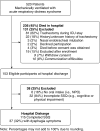Recovery from Dysphagia Symptoms after Oral Endotracheal Intubation in Acute Respiratory Distress Syndrome Survivors. A 5-Year Longitudinal Study
- PMID: 27983872
- PMCID: PMC5427721
- DOI: 10.1513/AnnalsATS.201606-455OC
Recovery from Dysphagia Symptoms after Oral Endotracheal Intubation in Acute Respiratory Distress Syndrome Survivors. A 5-Year Longitudinal Study
Abstract
Rationale: Nearly 60% of patients who are intubated in intensive care units (ICUs) experience dysphagia after extubation, and approximately 50% of them aspirate. Little is known about dysphagia recovery time after patients are discharged from the hospital.
Objectives: To determine factors associated with recovery from dysphagia symptoms after hospital discharge for acute respiratory distress syndrome (ARDS) survivors who received oral intubation with mechanical ventilation.
Methods: This is a prospective, 5-year longitudinal cohort study involving 13 ICUs at four teaching hospitals in Baltimore, Maryland. The Sydney Swallowing Questionnaire (SSQ), a 17-item visual analog scale (range, 0-1,700), was used to quantify patient-perceived dysphagia symptoms at hospital discharge, and at 3, 6, 12, 24, 36, 48, and 60 months after ARDS. An SSQ score greater than or equal to 200 was used to indicate clinically important dysphagia symptoms at the time of hospital discharge. Recovery was defined as an SSQ score less than 200, with a decrease from hospital discharge greater than or equal to 119, the reliable change index for SSQ score. Fine and Gray proportional subdistribution hazards regression analysis was used to evaluate patient and ICU variables associated with time to recovery accounting for the competing risk of death.
Measurements and main results: Thirty-seven (32%) of 115 patients had an SSQ score greater than or equal to 200 at hospital discharge; 3 died before recovery. All 34 remaining survivors recovered from dysphagia symptoms by 5-year follow-up, 7 (23%) after 6 months. ICU length of stay was independently associated with time to recovery, with a hazard ratio (95% confidence interval) of 0.96 (0.93-1.00) per day.
Conclusions: One-third of orally intubated ARDS survivors have dysphagia symptoms that persist beyond hospital discharge. Patients with a longer ICU length of stay have slower recovery from dysphagia symptoms and should be carefully considered for swallowing assessment to help prevent complications related to dysphagia.
Keywords: acute respiratory distress syndrome; deglutition; deglutition disorders; intubation; recovery of function.
Figures



Comment in
-
Dysphagia after Acute Respiratory Distress Syndrome. Another Lasting Legacy of Critical Illness.Ann Am Thorac Soc. 2017 Mar;14(3):307-308. doi: 10.1513/AnnalsATS.201612-1040ED. Ann Am Thorac Soc. 2017. PMID: 28248578 Free PMC article. No abstract available.
References
-
- Zilberberg MD, de Wit M, Shorr AF. Accuracy of previous estimates for adult prolonged acute mechanical ventilation volume in 2020: update using 2000-2008 data. Crit Care Med. 2012;40:18–20. - PubMed
-
- Wunsch H, Linde-Zwirble WT, Angus DC, Hartman ME, Milbrandt EB, Kahn JM. The epidemiology of mechanical ventilation use in the United States. Crit Care Med. 2010;38:1947–1953. - PubMed
-
- Ajemian MS, Nirmul GB, Anderson MT, Zirlen DM, Kwasnik EM. Routine fiberoptic endoscopic evaluation of swallowing following prolonged intubation: implications for management. Arch Surg. 2001;136:434–437. - PubMed
Publication types
MeSH terms
Grants and funding
LinkOut - more resources
Full Text Sources
Other Literature Sources
Medical

